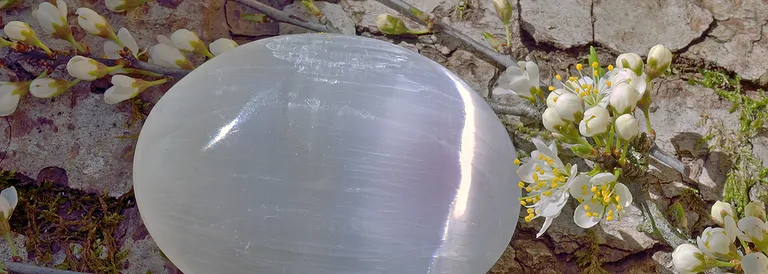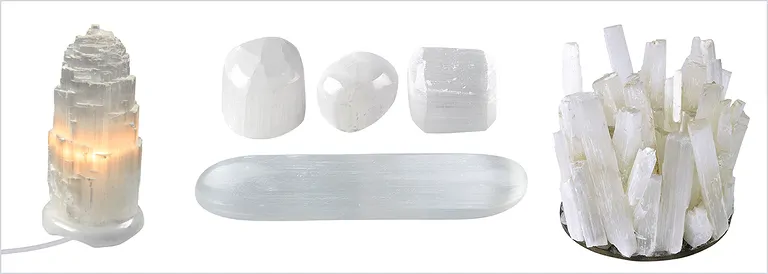
Alabaster and Selenite - Bearing, effect and application
Selenite and Alabaster - just Gypsum?!

Mineralogical profile Selenite
Chemical formula: CaSO4 . 2 H2O + Al,Fe,C
Mineral Class: Sulfate
Formation: 200 - 300 million years ago secondary to evaporation of salt lakes; often also by water absorption from Anhydrite.
Color: mostly white, sometimes grayish, reddish or brownish
Gloss: vitreous luster
Crystal system: monoclinic
Mohs hardness: 1.5 to 2
Cleavaability: Excellent cleavability
Localities, main supplying countries: worldwide; pieces in trade mostly from Morocco
Appearance: meter-sized, prismatic crystals; fibrous and radiating aggregates
Use: Selenite is a popular decorative stone, for exampl as a lamp or tea light.
For retailer only: Selenite lamps, tumbled stones, decorative item

Historical facts about Selenite
The Romans called the mineral selenite "lapis specularis," meaning "mirror stone." In Roman baths and the houses of wealthy citizens, window panes composed of several selenite panes were found. Because of its cleavability, Selenite could be worked well even at that time; Glass could not be made as flat and transparent at that time as it is today. In the encyclopedia "Naturalis historia", the Roman scholar Pliny the Elder (23 - 79) described the mining and use of selenite after visiting a selenite deposit in Spain.
Origin of the name Selenite and synonyms
The name "selenite" is derived from "Selene", the Greek goddess of the moon. The name was introduced by the Swedish chemist and mineralogist Johan Gottschalk Wallerius (1709-1785); he first used it for transparent Gypsum. In giving the name, Wallerius was probably inspired by the iridescent surface, which is reminiscent of moonlight. A legend assumes that the name selenite is due to the fact that particularly much selenite is found in moonlight,
Particularly transparent and flat selenite crystals are also called Marienglas or women's glass, since these were placed earlier instead of expensive glass panes for protection against images of Mary and other representations of saints. Other names for selenite, some of which are obsolete, are foliated gypsum, women's ice, gypsum glass, gypsum spar and late gypsum, and silk spar.

Selenite massage stones, tumbled stones, decorative items and more articles at wholesale prices
Use of Selenite
Selenite is due to its attractive appearance and good processing a popular stone for the production of decorative items, such as lamps or tea lights. These fascinate by the optical contrast of warm light and cool stone. In Feng Shui, selenite is partly used as protection from water veins.
Jewelry made of or with selenite hardly exists, because the material is too soft and too easily cleaved, for example, to be cut as a cabochon or drilled as a ball. For the production of gemstone water by putting the stones directly into the water, selenite is not suitable, because the mineral dissolves in the water. However, with the help of the initiation method, gemstone water can still be produced.
Historical records of the use of selenite in stone healing do not exist. Nowadays, the columnar shape makes selenite a popular stone for aligning the chakras along the body axis, as a support for meditation and for Reiki applications. Due to the neutral white color and the directionality of the fibers, selenite is sometimes used like Rock Crystal-Doppelender, for example, when laying a stone circle.
The well-known healer and author Ewald Kliegel recommends elongated massage stones of selenite to shield against external influences. When "outside" everything becomes too much, selenite can support to withdraw and (again) come to rest.
Selenite and selenide - one letter, big difference!
Occasionally, friends and fans of selenite products are alarmed by reports that selenite is contaminated with heavy metals, e.g. cadmium, and that selenite products are therefore hazardous to health. However, this is a confusion between selenite and selenide. The one letter at the end makes a big difference here and is by no means a different spelling. The only thing selenite and selenide have in common is the origin of the name - both terms are derived from the moon goddess Selene.
Selenite with T is a fibrous, natural gypsum, completely harmless, chemical formula CaSO₄-2H₂O.
Selenide with D or in the plural selenides are mostly toxic metal compounds with the chemical element selenium (chemical formula Se). These include, for example, the semiconductor material mercury selenide (HgSe) and the red colour pigment cadmium selenide (Cdse).